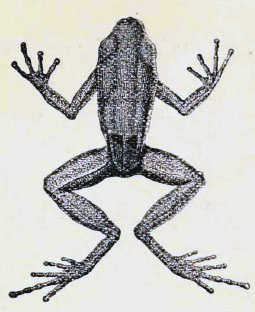Hyloxalus awa is a species of frog in the family Dendrobatidae. It is endemic to Ecuador and known from the western Andean slopes and the western Pacific lowlands.
Hyloxalus breviquartus is a species of frog in the family Dendrobatidae. It is found in the northern part of Cordillera Occidental in Antioquia, Colombia, and in Carchi Province in northwestern Ecuador. Colombian distribution may be wider. Its natural habitats are montane forests next to streams and very humid premontane forests. It is threatened by habitat loss, although it occurs in the Las Orquídeas National Natural Park, its type locality.
Hyloxalus cevallosi, also known as Palanda rocket frog, is a species of poison dart frogs in the family Dendrobatidae. It is named after Gabriel Cevallos García, a famous Ecuadorean writer. This species of frog occurs on the east side of the Andes in Ecuador in the Pastaza Province. Its natural habitats are very humid premontane and pluvial premontane forests.

Hyloxalus elachyhistus is a species of frog in the family Dendrobatidae. It is found in southern Ecuador and northern Peru, in the Huancabamba Depression and south to Cajabamba Province.
Hyloxalus exasperatus or the Yapitya rocket frog is a species of frog in the family Dendrobatidae. It is endemic to Ecuador and found on the eastern slopes of the Andes in Pastaza and Morona-Santiago Provinces. However, it is suggested that specimens from Pastaza represent a different, possibly undescribed species.
Hyloxalus fallax is a species of frogs in the family Dendrobatidae. It is endemic to Ecuador and only known from the region of its type locality in the Cotopaxi Province, on the western slopes of the Andes. Common name Cotopaxi rocket frog has been coined for this species.
Hyloxalus fuliginosus or the Quijos rocket frog is a species of frog in the family Dendrobatidae. It is endemic to Ecuador where it is known from the Amazonian slopes of the Andes in the northern Ecuador, with some sources reporting it from Colombia and Venezuela.
Hyloxalus infraguttatus is a species of frog in the family Dendrobatidae. It is found on the Pacific slopes of Ecuadorian Andes at elevations of 70–1,500 m (230–4,920 ft) asl.
Hyloxalus lehmanni is a species of frog in the family Dendrobatidae. It is found widely in Colombia from Antioquia southwards along the Cordillera Occidental and Cordillera Central to northern Ecuador.
Hyloxalus maquipucuna is a species of frog in the family Dendrobatidae. It is endemic to Ecuador where it is only known from its type locality in the Maquipucuna reserve, in the Pichincha Province.
Hyloxalus mystax is a species of frog in the family Dendrobatidae. It is endemic to Ecuador where it is only known from its type locality on the Cordillera del Cóndor at 1,830 m (6,000 ft) asl.

Hyloxalus nexipus is a species of frog in the family Dendrobatidae. It is found on eastern slopes and foothills of the Andes from southeastern Ecuador south to the region of Yurimaguas in Peru.
Hyloxalus peculiaris is a species of frogs in the family Dendrobatidae. It is endemic to Ecuador where it is only known from its type locality, "Pailas" in the Morona-Santiago Province, on the eastern slope of the Andes.
Hyloxalus pulchellus is a species of frog in the family Dendrobatidae from the Andes of northern Ecuador and southern Colombia.
Hyloxalus pumilus is a species of frogs in the family Dendrobatidae. It is endemic to southern Ecuador where it is only known from its type locality in the Azuay Province.
Hyloxalus sauli is a species of frogs in the family Dendrobatidae. It is found on the eastern Andean slopes in Putumayo, Colombia, and in Sucumbíos, Napo, Orellana, and Pastaza Provinces, Ecuador. It is named after William Saul from the University of Kansas Natural History Museum.
Hyloxalus shuar is a species of frog in the family Dendrobatidae. It is endemic to Ecuador and Peru and is currently known from only two locations, though formerly widespread. The common English-language names Santiago rocket frog and Shuar rocket frog have been proposed for it.
Hyloxalus toachi is a species of frog in the family Dendrobatidae. It is endemic to northwestern Ecuador.

Paruwrobates whymperi, sometimes known as the Tanti rocket frog, is a species of frog in the family Dendrobatidae. It is endemic to west-central Ecuador and only known from Tanti, near San Francisco de Las Pampas, and from Mindo, Pichincha Province.
Hyloxalus maculosus, also known as spotted rocket frog, is a species of frogs in the family Dendrobatidae. It is endemic to the eastern slopes of Ecuadorian Andes in Napo and Pastaza provinces at elevations of 342 to 1,225 m asl.



